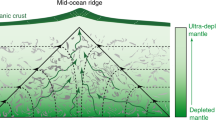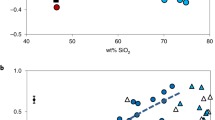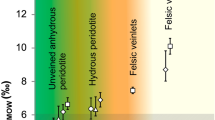Abstract
The Earth’s mantle contains non-radiogenic noble gas isotopes that imply transfer of noble gases from the atmosphere into the mantle through subduction. Hydrated serpentinite rocks within subducting oceanic lithosphere are recognized as key carriers of water and chlorine, but the pathways for noble gas subduction have been poorly constrained. Here we analyse the concentration of noble gas isotopes and halogens in rocks from the Ligurian Alps, Italy and the Betic Cordillera, Spain. These rocks and the fluid inclusions trapped within them preserve a record of serpentinite dehydration during progressively deeper stages of subduction. We find that the noble gas and halogen signature of serpentinites reflects that of sea water and sediment pore fluids. The fluids released become progressively depleted in noble gases and chlorine is subducted to greater depths than bromine or iodine. After complete breakdown of the serpentinites at mantle depths of around 70 km, the dehydrated rock residues still retain a seawater-derived noble gas signature and significant chlorine. We suggest that these samples are proxies for serpentinite dehydration in cold slabs at mantle depths of 200 km or greater. We conclude that atmospheric noble gases are readily incorporated into hydrous minerals formed close to the sea floor, and incompletely removed by subduction zone metamorphism. This implies that noble gases can be subducted to great depths in the Earth’s mantle.
This is a preview of subscription content, access via your institution
Access options
Subscribe to this journal
Receive 12 print issues and online access
$259.00 per year
only $21.58 per issue
Buy this article
- Purchase on Springer Link
- Instant access to full article PDF
Prices may be subject to local taxes which are calculated during checkout




Similar content being viewed by others
References
Hofmann, A. W. Mantle geochemistry: The message from oceanic volcanism. Nature 385, 219–229 (1997).
Rüpke, L. H., Morgan, J. P., Hort, M. & Connolly, J. A. D. Serpentine and the subduction zone water cycle. Earth Planet. Sci. Lett. 223, 17–34 (2004).
Schmidt, M. W. & Poli, S. Experimentally based water budgets for dehydrating slabs and consequences for arc magma generation. Earth Planet. Sci. Lett. 163, 361–379 (1998).
Green II, H. W., Chen, W-P. & Brudzinski, M. R. Seismic evidence of negligible water carried below 400-km depth in subducting lithosphere. Nature 467, 828–831 (2010).
Peacock, S. M. Fluid processes in subduction zones. Science 248, 329–337 (1990).
Sarda, P., Moreira, M. & Staudacher, T. Argon–lead isotopic correlation in Mid-Atlantic Ridge basalts. Science 283, 666–668 (1999).
Caffee, M. W. et al. Primordial noble cases from Earth’s mantle: Identification of a primitive volatile component. Science 285, 2115–2118 (1999).
Holland, G. & Ballentine, C. J. Seawater subduction controls the heavy noble gas composition of the mantle. Nature 441, 186–191 (2006).
Ozima, M. & Podosek, F. A. Noble Gas Geochemistry 2nd edn (Cambridge Univ. Press, 2002).
Holland, G., Cassidy, M. & Ballentine, C. J. Meteorite Kr in Earth’s mantle suggests a late accretionary source for the atmosphere. Science 326, 1522–1525 (2009).
Bostock, M. G., Hyndman, R. D., Rondenay, S. & Peacock, S. M. An inverted continental Moho and serpentinization of the forearc mantle. Nature 417, 536–538 (2002).
Ranero, C. R., Phipps Morgan, J., McIntosh, K. & Reichert, C. Bending-related faulting and mantle serpentinization at the Middle America trench. Nature 425, 367–373 (2003).
Ulmer, P. & Trommsdorff, V. Serpentine stability to mantle depths and subduction-related magmatism. Science 268, 858–861 (1995).
Sharp, Z. D. & Barnes, J. D. Water-soluble chlorides in massive seafloor serpentinites: A source of chloride in subduction zones. Earth Planet. Sci. Lett. 226, 243–254 (2004).
Bonifacie, M. et al. Chlorine isotopic composition in seafloor serpentinites and high-pressure metaperidotites. Insights into oceanic serpentinization and subduction processes. Geochim. Cosmochim. Acta 72, 126–139 (2008).
Matsuda, J. & Nagao, K. Noble-gas abundances in a deep-sea sediment core from eastern equatorial Pacific. Geochem. J. 20, 71–80 (1986).
Moreira, M. et al. He and Ne isotopes in oceanic crust: Implications for noble gas recycling in the mantle. Earth Planet. Sci. Lett. 216, 635–643 (2003).
Staudacher, T. & Allègre, C. J. Recycling of oceanic crust and sediments: The noble gas subduction barrier. Earth Planet. Sci. Lett. 89, 173–183 (1988).
Scambelluri, M. et al. The fate of B, Cl and Li in the subducted oceanic mantle and in the antigorite breakdown fluids. Earth Planet. Sci. Lett. 222, 217–234 (2004).
Bose, K. & Navrotsky, A. Thermochemistry and phase equilibria of hydrous phases in the system MgO–SiO2–H2O: Implications for volatile transport to the mantle. J. Geophys. Res. 103, 9713–9719 (1998).
Bach, W. & Frueh-Green, G. L. Alteration of the oceanic lithosphere and implications for seafloor processes. Elements 6, 173–178 (2010).
Dick, H. J. B., Lin, J. & Schouten, H. An ultraslow-spreading class of ocean ridge. Nature 426, 405–412 (2003).
Bromiley, G. D. & Pawley, A. R. The stability of antigorite in the systems MgO–SiO2–H2O(MSH) and MgO–Al2O3–SiO2–H2O (MASH): The effects of Al3+ substitution on high-pressure stability. Am. Miner. 88, 99–108 (2003).
Kent, A. J. R. et al. Chlorine in submarine glasses from the Lau Basin: Seawater contamination and constraints on the composition of slab-derived fluids. Earth Planet. Sci. Lett. 202, 361–377 (2002).
Sun, W. D. et al. Chlorine in submarine volcanic glasses from the eastern Manus basin. Geochim. Cosmochim. Acta 71, 1542–1552 (2007).
Hermann, J., Müntener, O. & Scambelluri, M. The importance of serpentinite mylonites for subduction and exhumation of oceanic crust. Tectonophysics 327, 225–238 (2000).
Scambelluri, M. et al. High salinity fluid inclusions formed from recycled seawater in deeply subducted alpine serpentinite. Earth Planet. Sci. Lett. 148, 485–499 (1997).
Trommsdorff, V., Sanchez-Vizcaino, V. L., Gomez-Pugnaire, M. T. & Muntener, O. High pressure breakdown of antigorite to spinifex-textured olivine and orthopyroxene, SE Spain. Contrib. Mineral. Petrol. 132, 139–148 (1998).
Scambelluri, M. et al. Incompatible element-rich fluids released by antigorite breakdown in deeply subducted mantle. Earth Planet. Sci. Lett. 192, 457–470 (2001).
Fruh-Green, G. L., Scambelluri, M. & Vallis, F. O–H isotope ratios of high pressure ultramafic rocks: Implications for fluid sources and mobility in the subducted hydrous mantle. Contrib. Mineral. Petrol. 141, 145–159 (2001).
Rubatto, D. & Scambelluri, M. U–Pb dating of magmatic zircon and metamorphic baddeleyite in the Ligurian eclogites (Voltri Massif, Western Alps). Contrib. Mineral. Petrol. 146, 341–355 (2003).
Muramatsu, Y. et al. Halogen concentrations in pore waters and sediments of the Nankai Trough, Japan: Implications for the origin of gas hydrates. Appl. Geochem. 22, 534–556 (2007).
Podosek, F. A., Honda, M. & Ozima, M. Sedimentary noble gases. Geochim. Cosmochim. Acta 44, 1875–1884 (1980).
Moreira, M., Kunz, J. & Allegre, C. Rare gas systematics in popping rock: Isotopic and elemental compositions in the upper mantle. Science 279, 1178–1181 (1998).
Sumino, H. et al. Seawater-derived noble gases and halogens preserved in exhumed mantle wedge peridotite. Earth Planet. Sci. Lett. 294, 163–172 (2010).
Kohlstedt, D. L., Keppler, H. & Rubie, D. C. Solubility of water in the alpha, beta and gamma phases of (Mg,Fe)(2)SiO4 . Contrib. Mineral. Petrol. 123, 345–357 (1996).
Patterson, D. B., Honda, M. & McDougall, I. Atmospheric contamination: A possible sorce for heavy noble gases in basalts from Loihi Seamount, Hawaii. Geophys. Res. Lett. 17, 705–708 (1990).
Ballentine, C. J. & Barfod, D. N. The origin of air-like noble gases in MORB and OIB. Earth Planet. Sci. Lett. 180, 39–48 (2000).
Graham, D. W. in Noble Gases in Geochemistry and Cosmochemistry Vol. 47 (eds Porcelli, D., Ballentine, C. J. & Wieler, R.) 245–317 (Mineralogical Society of America, 2002).
Hilton, D. R., Fischer, T. P. & Marty, B. in Noble Gases in Geochemistry and Cosmochemistry Vol. 47 (eds Porcelli, D., Ballentine, C. & Wieler, R.) 319–370 (Mineralogical Society of America, 2002).
Ikeda, Y. et al. Noble gases in pillow basalt glasses from the northern Mariana Trough back-arc basin. Island Arc 7, 471–478 (1998).
Bach, W. & Niedermann, S. Atmospheric noble gases in volcanic glasses from the southern Lau Basin: Origin from the subducting slab? Earth Planet. Sci. Lett. 160, 297–309 (1998).
Trieloff, M. et al. The nature of pristine noble gases in mantle plumes. Science 288, 1036–1038 (2000).
Raquin, A. & Moreira, M. Atmospheric 38Ar/36Ar in the mantle: Implications for the nature of the terrestrial parent bodies. Earth Planet. Sci. Lett. 287, 551–558 (2009).
Ballentine, C. J., Marty, B., Lollar, B. S. & Cassidy, M. Neon isotopes constrain convection and volatile origin in the Earth’s mantle. Nature 433, 33–38 (2005).
Yokochi, R. & Marty, B. A determination of the neon isotopic composition of the deep mantle. Earth Planet. Sci. Lett. 225, 77–88 (2004).
Kendrick, M. A. & Phillips, D. New constraints on the release of noble gases during in vacuo crushing and application to scapolite Br–Cl–I and 40Ar/39Ar age determinations. Geochim. Cosmochim. Acta 73, 5673–5692 (2009).
Kendrick, M. A., Honda, M., Oliver, N. H. S. & Phillips, D. The noble gas systematics of late-orogenic H2O–CO2 fluids, Mt Isa, Australia. Geochim. Cosmochim. Acta 75, 1428–1450 (2011).
Jambon, A., Deruelle, B., Dreibus, G. & Pineau, F. Chlorine and bromine abundance in MORB: The contrasting behaviour of the Mid-Atlantic Ridge and East Pacific Rise and implications for chlorine geodynamic cycle. Chem. Geol. 126, 101–117 (1995).
Schilling, J. C., Unni, C. K. & Bender, M. L. Origin of chlorine and bromine in the oceans. Nature 273, 631–636 (1978).
Acknowledgements
S. Szczepanski and I. Yatsevich are thanked for technical assistance in the Melbourne and ANU noble gas laboratories. M.A.K. acknowledges discussions with several colleagues, including T. John, who supplied samples ET4B2 and ETCl74, A. Giuliani, J. Hermann and T. Pettke. M.A.K. is the recipient of an Australian Research Council QEII Fellowship (project number DP 0879451). M.S. acknowledges the Italian MIUR and the University of Genova for funding.
Author information
Authors and Affiliations
Contributions
M.A.K. was responsible for project conception and the majority of analyses; M.S. and M.H. made equal contributions in terms of sample selection and petrology (M.S.) and Ne analyses (M.H.). D.P. is director of the noble gas laboratory at the University of Melbourne. M.A.K. authored the manuscript with contributions from M.S., M.H. and D.P.
Corresponding author
Ethics declarations
Competing interests
The authors declare no competing financial interests.
Supplementary information
Supplementary Information
Supplementary Information (PDF 1133 kb)
Supplementary Information
Supplementary Information (XLS 568 kb)
Rights and permissions
About this article
Cite this article
Kendrick, M., Scambelluri, M., Honda, M. et al. High abundances of noble gas and chlorine delivered to the mantle by serpentinite subduction. Nature Geosci 4, 807–812 (2011). https://doi.org/10.1038/ngeo1270
Received:
Accepted:
Published:
Issue Date:
DOI: https://doi.org/10.1038/ngeo1270
This article is cited by
-
Carbonate-rich crust subduction drives the deep carbon and chlorine cycles
Nature (2023)
-
Earth’s missing argon paradox resolved by recycling of oceanic crust
Nature Geoscience (2022)
-
Dehydration of brucite + antigorite under mantle wedge conditions: insights from the direct comparison of microstructures before and after experiments
Contributions to Mineralogy and Petrology (2022)
-
Petrogenetic and metallogenic implications of the Late Mesozoic intrusive rocks in the Xuancheng ore district, eastern China: insight from in situ analysis of apatite
Geosciences Journal (2022)
-
Halogens in serpentinised-troctolites from the Atlantis Massif: implications for alteration and global volatile cycling
Contributions to Mineralogy and Petrology (2022)



